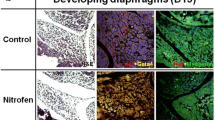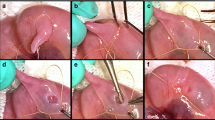Abstract
Background
Prenatal mortality in newborn infants with congenital diaphragmatic hernia (CDH) has been attributed to increased amounts of liver hernia ion through the diaphragmatic defect. Antenatal studies in human and rodent fetus with CDH further demonstrated a contribution of the developing liver in the pathogenesis of CDH. The abnormal hepatic growth in experimental animal models, therefore, indicates a disruption of normal liver development in CDH. However, the underlying structural, histological and functional changes in the liver of animals with CDH remain unclear. We design this study to test the hypothesis that the morphological and cellular liver development is altered in the nitrogen-induced CDH model.
Methods
Pregnant rats were exposed to either olive oil or nitrofen on day 9 of gestation (D9). Livers and chest were harvested on D21 and divided into two groups: control (n = 8), nitrofen with CDH (CDH, n = 8). Haematoxylin–eosin (Straub et al. Histopathology 68:617–631, 2013) staining was performed to evaluate underlying morphological changes. Apoptosis was checked by using TUNEL staining and apoptotic cell number was counted on 16–16 slides in 25 fields by two independent viewers. Hepatic lipid droplet expressions were evaluated by hepatic adipose differentiation-related protein (ARDP) expression.
Results
Compared to controls markedly increased hypertrophy was seen in CDH group. Significantly increased apoptotic cell numbers were detected in CDH group compared to controls (5.1 ± 1.5 vs 2.1 ± 0.6) (p < 0.05). The relative mRNA expression levels of ARDP were significantly reduced in CDH group compared to controls. Immunohistochemistry showed markedly decreased hepatic ADRP immunoreactivity in CDH fetuses compared to controls.
Conclusions
Our findings provide strong evidence of hepatic hypertrophy and increased cell apoptosis in the liver of nitrofen-induced CDH. These morphological changes may affect liver lipid droplet expression function.



Similar content being viewed by others
References
Colvin J, Bower C, Dickinson JE et al (2005) Outcomes of congenital diaphragmatic hernia: a population-based study in Western Australia. Pediatrics 116:e356–e363
Straub BK, Gyoengyoesi B, Koenig M et al (2013) Adipophilin/perilipin-2 as a lipid droplet-specific marker for metabolically active cells and diseases associated with metabolic dysregulation. Histopathology 62:617–631
Stege G, Fenton A, Jaffray B (2003) Nihilism in the 1990s: the true mortality of congenital diaphragmatic hernia. Pediatrics 112:532–535
Robinson PD, Fitzgerald DA (2007) Congenital diaphragmatic hernia. Paediatric respiratory reviews 8:323–334 (quiz 334–325)
Werner NL, Coughlin M, Kunisaki SM et al (2015) Prenatal and postnatal markers of severity in congenital diaphragmatic hernia have similar prognostic ability. Prenatal Diag. doi:10.1002/pd.4721
Zamora IJ, Olutoye OO, Cass DL et al (2014) Prenatal MRI fetal lung volumes and percent liver herniation predict pulmonary morbidity in congenital diaphragmatic hernia (CDH). J Pediatr Surg 49:688–693
Nagata K, Usui N, Terui K et al (2015) Risk factors for the recurrence of the congenital diaphragmatic hernia-report from the long-term follow-up study of Japanese CDH study group. Eur J Pediatr Surg 25:9–14
Terui K, Nagata K, Hayakawa M et al (2015) Growth assessment and the risk of growth retardation in congenital diaphragmatic hernia: a long-term follow-up study from the Japanese congenital diaphragmatic hernia study group. Eur J Pediatr Surg [Epub ahead of print]
Langwieler T, Fiegel HC, Alaamian M et al (2004) The relationship of diaphragmatic defect, liver growth, and lung hypoplasia in nitrofen-induced congenital diaphragmatic hernia in the rat. Pediatr Surg Int 20:509–514
Tobin KA, Harsem NK, Dalen KT et al (2006) Regulation of ADRP expression by long-chain polyunsaturated fatty acids in BeWo cells, a human placental choriocarcinoma cell line. J Lipid Res 47:815–823
Friedmacher F, Fujiwara N, Hofmann AD et al (2014) Evidence for decreased lipofibroblast expression in hypoplastic rat lungs with congenital diaphragmatic hernia. Pediatr Surg Int 30:1023–1029
Shi HB, Yu K, Luo J et al (2015) Adipocyte differentiation-related protein promotes lipid accumulation in goat mammary epithelial cells. J Dairy Sci 98:6954–6964
Montedonico S, Nakazawa N, Puri P (2008) Congenital diaphragmatic hernia and retinoids: searching for an etiology. Pediatr Surg Int 24:755–761
Noble BR, Babiuk RP, Clugston RD et al (2007) Mechanisms of action of the congenital diaphragmatic hernia-inducing teratogen nitrofen. Am J Physiol Lung Cell Mol Physiol 293:L1079–L1087
Kutasy B, Gosemann JH, Doi T et al (2012) Nitrofen interferes with trophoblastic expression of retinol-binding protein and transthyretin during lung morphogenesis in the nitrofen-induced congenital diaphragmatic hernia model. Pediatr Surg Int 28:143–148
Gosemann JH, Doi T, Kutasy B et al (2012) Alterations of peroxisome proliferator-activated receptor gamma and monocyte chemoattractant protein 1 gene expression in the nitrofen-induced hypoplastic lung. J Pediatr Surg 47:847–851
Kling DE, Cavicchio AJ, Sollinger CA et al (2010) Nitrofen induces apoptosis independently of retinaldehyde dehydrogenase (RALDH) inhibition. Birth Defects Res B Dev Reprod Toxicol 89:223–232
Manson JM (1986) Mechanism of nitrofen teratogenesis. Environ Health Perspect 70:137–147
Brown TJ, Manson JM (1986) Further characterization of the distribution and metabolism of nitrofen in the pregnant rat. Teratology 34:129–139
Clugston RD, Zhang W, Greer JJ (2012) Early development of the primordial mammalian diaphragm and cellular mechanisms of nitrofen-induced congenital diaphragmatic hernia. Birth Defects Res A Clin Mol Teratol 88:15–24
Columbano A, Shinozuka H (1996) Liver regeneration versus direct hyperplasia. FASEB J 10:1118–1128
Michalopoulos GK, DeFrances MC (1997) Liver regeneration. Science 276:60–66
Author information
Authors and Affiliations
Corresponding author
Ethics declarations
Funding
This research was supported by the National Children’s Research Centre and the Children’s Medical and Research Foundation.
Rights and permissions
About this article
Cite this article
Takahashi, H., Kutasy, B., Friedmacher, F. et al. Expression of hepatic lipid droplets is decreased in the nitrofen model of congenital diaphragmatic hernia. Pediatr Surg Int 32, 155–160 (2016). https://doi.org/10.1007/s00383-015-3827-4
Accepted:
Published:
Issue Date:
DOI: https://doi.org/10.1007/s00383-015-3827-4




